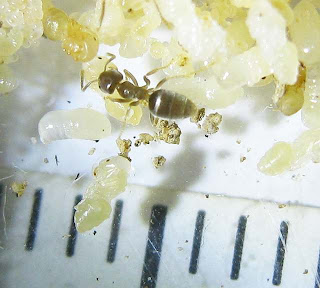Tapinoma melanocephalum is a small odorous ant that is more commonly found indoor than outdoor. The indoor species are usually lighter in color from those found outdoor especially in forest, wooded and agricultural areas. The outdoor species typically have longer legs and antennae.
This fast running tiny small pest ant have a similar habitat preference as the other common pest ant Monomorium pharaonis.
And like Monomorium pharaonis. they can live in relatively dry places, their workers traveled long distances to sources of water to collect the water back for their nest. They find their way into water containers to drink and some drowned fouling the water.
Their tiny size allows them to gain access to food in tight containers making them adept at thriving in human habitations.
Workers and queen of Tapinoma melanocephalum.
Workers tending to the brood.
Workers and queen of Tapinoma melanocephalum.
The workers of Tapinoma Melanocephalum.

A callow worker of Tapinoma Melanocephalum species.
A young worker with a pupa.
Some workers of Tapinoma melanocephalum tending to the brood. Some are still in their callow colours.
A worker of Tapinoma melanocephalum - side profile.
A dark colored species of Tapinoma also found in homes.
This is not as common as the species above but both are about the same size.
Tapinoma sp.

Tapinoma Sp2: An Outdoor Species.
This outdoor Tapinoma species although the same size, has legs and antennae that are much longer.

Close-up of this Tapinoma species shows the clearly evident longer legs and antennae. The longer limbs makes them appear to be slimmer. Because these ants are very small unless you examine them close-up you would not be able to see that this species found in the wild is different from the "domesticated" species of Tapinoma Melanocephalum.
Here a male (above) drone and a worker.
Tapinoma Sp3: Another Outdoor Species.
Another species of Tapinoma not found inside housing and buildings.
And here is the reason - the gyne of this Tapinoma species are as large as those of the black crazy ants
Paratrechina longicornis.
Tapinoma sessile the odorous house ant is another species of this genus. This species has a particular much stronger smell and thus its common name.
Control And Eradications.
Solution based poison baiting is the fastest eradication methods for household pest ants such as Pharaoh ants and Ghost ants. Some documentations listed boric acid added to water or sugar water as an effective poison bait against Tapinoma melanocephalum. The same can be applied for
Monomorium pharoanis.
Chemical sprays are the lest effective (unless the various nest locations are tracked down and repeatedly sprayed over a period of one to two months), followed by fumigation.
These pest ants which includes the black crazy ants because of their polygynous nest composition tend to have dispersed nests spread out over the residence and even across several residences in the case of apartment and high rise dwellers.
Of course keeping the residence clean and keeping stored food in well sealed containers will go a long way to minimise infestations as well as re-infestations.
Last Updated: 2011 09 22
© 2011 Quah. All rights reserved.






















Hi there,
ReplyDeleteBeen trying to get you for a long time. Really impressed with your knowledge of ants and termites. I'm am also really interested in myrmecology, especially in ants that are around our region (South East Asia). Boy am I excited to find you. Please contact me via email and we could talk more.